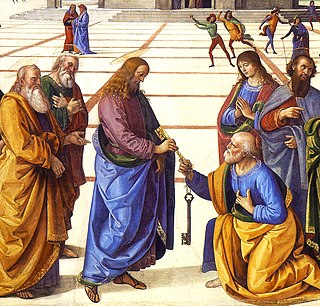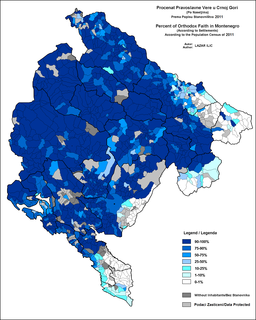
The Coptic Orthodox Church of Alexandria is an Oriental Orthodox Christian church based in Egypt, Africa and the Middle East. The head of the Church and the See of Alexandria is the Patriarch of Alexandria on the Holy See of Saint Mark, who also carries the title of Coptic Pope. The See of Alexandria is titular, and today the Coptic Pope presides from Saint Mark's Coptic Orthodox Cathedral in the Abbassia District in Cairo. The church follows the Alexandrian Rite for its liturgy, prayer and devotional patrimony. With 18–22 million members worldwide, whereof about 15 to 20 million are in Egypt, it is the country's largest Christian church.

The Eastern Orthodox Church, officially the Orthodox Catholic Church, is the second-largest Christian church, with approximately 260 million baptised members. It operates as a communion of autocephalous churches, each governed by its bishops in local synods. Roughly half of Eastern Orthodox Christians live in Russia. The church has no central doctrinal or governmental authority analogous to the Bishop of Rome, but the Ecumenical Patriarch of Constantinople is recognised by all as primus inter pares of the bishops. As one of the oldest surviving religious institutions in the world, the Eastern Orthodox Church has played a prominent role in the history and culture of Eastern and Southeastern Europe, the Caucasus, and the Near East.

Orthodox Judaism is a collective term for the traditionalist branches of contemporary Judaism. Theologically, it is chiefly defined by regarding the Torah, both Written and Oral, as literally revealed by God on Mount Sinai and faithfully transmitted ever since.

The Russian Orthodox Church, alternatively legally known as the Moscow Patriarchate, is one of the autocephalous Eastern Orthodox Christian churches. The primate of the ROC is the Patriarch of Moscow and all Rus'. The ROC, as well as its primate, officially ranks fifth in the Orthodox order of precedence, immediately below the four ancient patriarchates of the Greek Orthodox Church: Constantinople, Alexandria, Antioch, and Jerusalem. Since 15 October 2018, the ROC is not in communion with the Ecumenical Patriarch of Constantinople, having unilaterally severed ties in reaction to the establishment of the Orthodox Church of Ukraine, which was finalised by the Ecumenical Patriarchate on 5 January 2019.
This is a directory of patriarchs, archbishops, and bishops across various Christian denominations. To find an individual who was a bishop, see the most relevant article linked below or Category:Bishops.

A religious denomination is a subgroup within a religion that operates under a common name, tradition, and identity.

Autocephaly is the status of a hierarchical Christian Church whose head bishop does not report to any higher-ranking bishop. The term is primarily used in Eastern Orthodox and Oriental Orthodox churches. The status has been compared with that of the churches (provinces) within the Anglican Communion.

The highest-ranking bishops in Eastern Orthodoxy, Oriental Orthodoxy, the Catholic Church, and the Church of the East are termed patriarchs.

Orthodoxy is adherence to correct or accepted creeds, especially in religion. In the Christian sense the term means "conforming to the Christian faith as represented in the creeds of the early Church." The first seven ecumenical councils were held between the years of 325 and 787 with the aim of formalizing accepted doctrines.
A Christian denomination is a distinct religious body within Christianity, identified by traits such as a name, organization, leadership and doctrine. The Roman Catholic Church, Eastern Orthodox Church, and Oriental Orthodoxy, meaning the large majority, all self-describe as churches, whereas many Protestant denominations self-describe as congregations or fellowships. Divisions between one group and another are defined by authority and doctrine; issues such as the nature of Jesus, the authority of apostolic succession, ecclesiology, eschatology, and papal primacy may separate one denomination from another. Groups of denominations—often sharing broadly similar beliefs, practices, and historical ties—are sometimes known as "branches of Christianity". These branches differ in many ways, especially through differences in practices and belief.

The Serbian Orthodox Church is one of the autocephalous Eastern Orthodox Christian Churches. It is the second-oldest Slavic Orthodox Church in the world.
The Evangelical Orthodox Church (EOC), founded in 1979, is a small Christian syncretic denomination established by former leaders of Campus Crusade for Christ, who, reacting against the freewheeling Jesus People movement, developed their own synthesis of Evangelicalism, Eastern Orthodoxy, and Shepherding Movement principles.

The Croatian Orthodox Church was a religious body created during World War II by the Fascist Ustaše regime in the Independent State of Croatia (NDH). It was created in order to assimilate the large Serb minority and also to unite other Orthodox communities into a state-based Orthodox Church.

The Malabar Independent Syrian Church, also known as the Thozhiyur Church, is a Christian church centred in Kerala, India. It is one of the churches of the Saint Thomas Christian community, which traces its origins to the evangelical activity of Thomas the Apostle in the 1st century.

The Belarusian Autocephalous Orthodox Church, which has sometimes abbreviated its name as the B.A.O. Church or the BAOC, is a religious body in the Eastern Orthodox tradition.

Eastern Orthodoxy in Montenegro refers to adherents, religious communities, institutions and organizations of Eastern Orthodox Christianity in Montenegro. It is the largest Christian denomination in the country. According to the latest census of 2011, 446,858 citizens of Montenegro (72.07%) registered as Eastern Orthodox Christians. The majority of Eastern Orthodox people in Montenegro are adherents of the Serbian Orthodox Church. A minor percentage supports the noncanonical and unrecognized Montenegrin Orthodox Church.
Oriental Orthodoxy is the communion of Eastern Christian Churches that recognize only three ecumenical councils — the First Council of Nicaea, the First Council of Constantinople and the Council of Ephesus. They reject the dogmatic definitions of the Council of Chalcedon. Hence, these Churches are also called Old Oriental Churches or Non-Chalcedonian Churches.

The Oriental Orthodox Churches are a group of Christian churches adhering to miaphysite Christology and theology, and together have 60 to 70 million members worldwide.
Orthodox Jewish feminism is a movement in Orthodox Judaism which seeks to further the cause of a more egalitarian approach to Jewish practice within the bounds of Jewish Law. The major organizations of this movement is the Jewish Orthodox Feminist Alliance (JOFA) in North America, and Women of the Wall (WOW) and its affiliates in Israel and internationally, known as ICWOW - The International Committee for Women of the Wall. In Israel, the leading Orthodox feminist organization is Kolech <http://www.kolech.org.il>, started by Dr. Hannah Kehat. Australia has one Orthodox partnership minyan, Shira Hadasha <http://www.shira.org.au>, in Melbourne.












